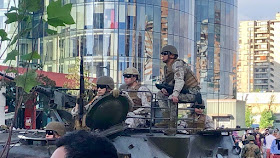 |
| Glaciers, fires, storms, and heat - the link between extreme weather and urban violence |
As we enter a new decade, I can’t help but wonder: How might my work and the work of other safety and crime prevention professionals be affected as temperatures continue to rise and weather conditions become even more extreme?
I am fortunate to have lived and worked in various countries, including Australia and Canada. People often associate the first with hot weather and beaches and the latter with cold winters and snow. This is especially true at this time of year when large parts of Australia are experiencing extremely high temperatures and devastating fires while Canada may be bracing for the next polar vortex this winter.
Are these two countries, on the opposite sides of the globe, struggling with contrasting environmental conditions that relate directly to contrasting crime and safety concerns?
 |
| Brilliant sunsets can indicate air particles from distant forest fires |
SEASONAL VARIATIONS?
There is long-standing research on violence and the thermal environment, or what is sometimes called the seasonality of crime. It reminded me of research I came across a few years ago about the possible association between temperature and crime.
That research found a correlation between warmer weather and various forms of crime and incidents and attributed this to an increase in outdoor activities during warmer days. The researchers of this study in Philadelphia also suggested that extreme temperatures, especially extremely cold, have the opposite effect as people are discouraged to go outdoors.
However, there is Canadian research contradicting that view and suggesting violence can also increase at the opposite end of the thermal scale.
One 1995 study in Canada’s Arctic Nunavut Territory reported that violence rates among the Inuit in the north were far higher in Baffin Island villages (most of which are above the Arctic Circle) than those in the warmer cities over a thousand miles (2,000 kilometers) to the south.
 |
| Climate stress and crime is a distant meditation - until it appears in front of us |
THERMAL EXTREMES AND VIOLENCE
While the Arctic study is explained through cultural and sociological causes, the Philadelphia study falls into a group of opportunity-theories that suggest comfortable weather conditions at any time of the year (warm gentle summers, balmy winters) are associated with the increased number of people outdoors resulting in increased concentration of both targets and potential offenders.
Other studies suggest the rise in alcohol consumption during the hot months of the year contributes more to murders and sexual assault, as well as other crimes such as road rage. This is especially a problem where temperature variations are large. Therefore, in these instances, it appears extremes in high temperatures or mango madness might be behind violent and aggressive behavior.
The homicide data in the State of Queensland, Australia for the past 22 years show a somewhat increased homicide rate during the hottest months of the year: December and January. This association was especially strong for the tropical north where temperatures are most extreme.
A NEW PATTERN EMERGES
However, when the data were examined for the Brisbane City police division for both homicide and all crimes respectively, they found no identifiable monthly patterns. This suggests that while temperature conditions may be part of the crime puzzle, we cannot draw conclusions about crime based on this single variable.
Perhaps thermal effects on violence apply to both high and low-temperature extremes, as the Canadian research suggests? It seems that the opportunity-theory does not always explain why some places are less safe than others, especially in relation to temperature.
This has been our experience during SafeGrowth programming in neighborhoods throughout the world. Even with extreme temperatures, healthy and vibrant neighborhoods with plenty of pro-social opportunities tend to be safer. Could it be that, whatever temperature extremes a community suffers, opportunities for pro-social behavior are a powerful prescription for building healthy communities with fewer crime opportunities?
THOUGHTS FOR THE NEXT DECADE
 |
| Climate change and crime in the future A new kind of city-building |
"Between 2010 and 2099, climate change will cause an additional 22,000 murders, 180,000 cases of rape, 1.2 million aggravated assaults, 2.3 million simple assaults, 260,000 robberies, 1.3 million burglaries, 2.2 million cases of larceny, and 580,000 cases of vehicle theft in the United States."Sobering words as we begin a new year!
And yet, as we have seen over the past few years, there are solutions at hand if we choose to adopt them. Collectively we can find effective answers to both halt the progression of global warming and to address community safety challenges that may be associated with the temperature effect.


























